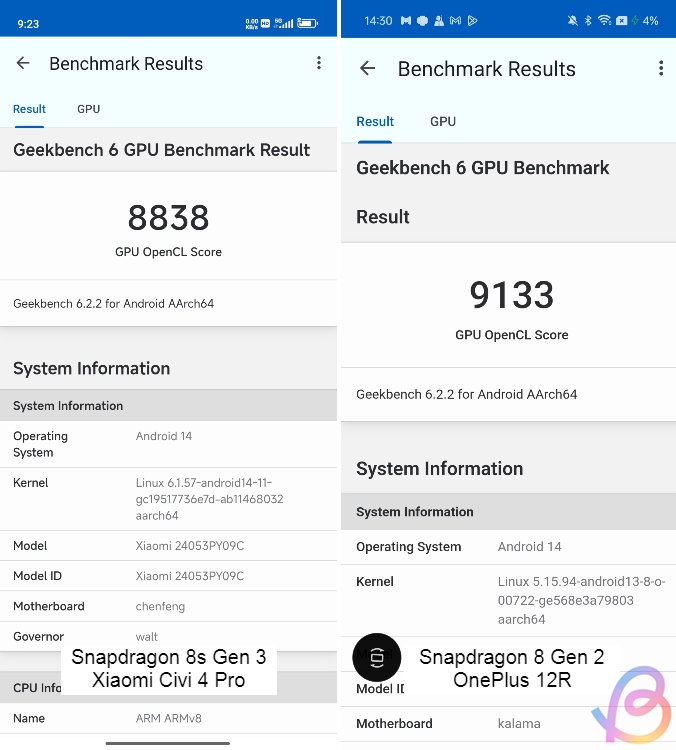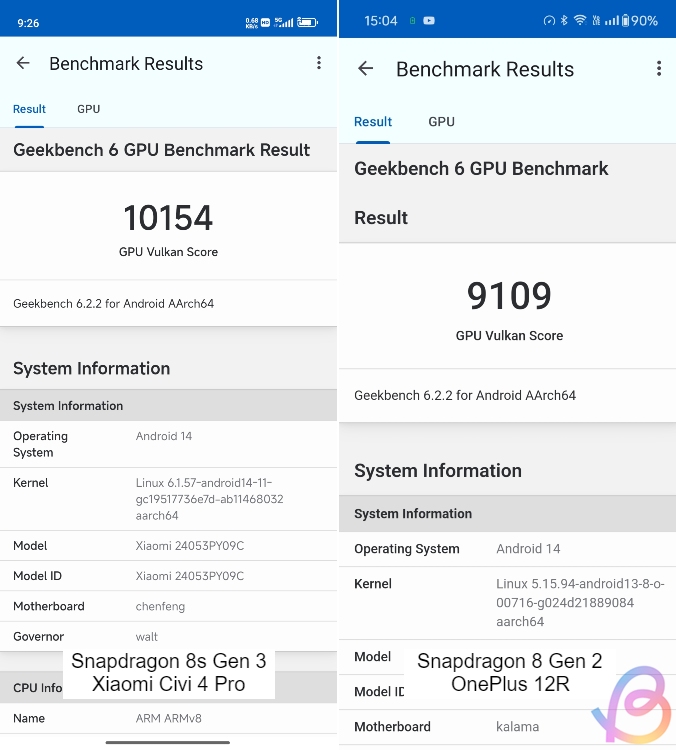We recently compared the Snapdragon 8s Gen 3 and Snapdragon 8 Gen 3 and concluded that there are significant gaps in performance between the two chipsets, with the former not offering the same flagship-tier performance. We also pitted the newly launched Snapdragon 7 Plus Gen 3 against the Snapdragon 8 Gen 2, the previous-gen flagship chipset, to evaluate their performance.
And if you look at it objectively, then the 8 Gen 3s seems closer in performance to the SD 7+ Gen 3 and SD 8 Gen 2. Therefore, here is a benchmark comparison between the Snapdragon 8s Gen 3 and Snapdragon 8 Gen 2, including Geekbench, AnTuTu, CPU Throttling test, and more.
Note:
We ran the tests on the Xiaomi Civi 4 Pro powered by the Snapdragon 8s Gen 3 and the OnePlus 12R powered by the Snapdragon 8 Gen 2.
Specs Comparison
Before you proceed, take a look at the specs for the Snapdragon 8s Gen 3 and Snapdragon 8 Gen 2. You can also head to our explainer on the Snapdragon chipset naming scheme to understand the new nomenclature.
| Snapdragon 8s Gen 3 | Snapdragon 8 Gen 2 | |
|---|---|---|
| Release Data | March 2024 | November 2024 |
| Process Node | TSMC 4nm | TSMC 4nm |
| CPU | Octa-core Kryo CPU 1x 3.0GHz (Cortex-X4) 4x 2.8GHz (Cortex-A720) 3x 2.0GHz (Cortex-A520) |
Octa-core Kryo CPU 1x 3.2GHz (Cortex-X3) 2x 2.8GHz (Cortex-A715) 2x 2.8GHz (Cortex-A710) 3x 2.0GHz (Cortex-A510) |
| GPU | Adreno 735 Hardware-accelerated Ray Tracing AFME 2.0 |
Adreno 740 GPU Hardware-accelerated Ray Tracing Unreal Engine 5 Game Post Processing Accelerator |
| NPU | Hexagon NPU Run AI models up to 10B parameters |
Hexagon NPU |
| Camera Support | Cognitive ISP, Triple 18-bit ISPs Up to 200MP photo capture 108MP ZSL, 64+36 ZSL, 36+36+36 ZSL 4K HDR video capture at 60 FPS |
18-Bit Spectra ISP Cognitive ISP Snapdragon Sight |
| Connectivity | Wi-Fi 7, Bluetooth 5.4, LE | Wi-Fi 7, Bluetooth 5.3, LE |
| Modem | Snapdragon X70 5G Modem Peak Download Speed 6.5 Gbps Peak Upload Speed 3.5 Gbps |
Snapdragon X70 5G Modem Peak Download Speed 10 Gbps Peak Upload Speed 3.5 Gbps |
| Storage / RAM Support | UFS 4.0 LPDDR5X memory up to 4200MHz |
UFS 4.0 LPDDR5X memory up to 4200MHz |
| AV1 Codec Support | HW-accelerated AV1 Decode only | HW-accelerated AV1 Decode only |
| NavIC Support | Yes | Yes |
Geekbench 6 CPU Score
As it’s evident from the Geekbench 6 CPU test, the Snapdragon 8s Gen 3 performs on similar lines to the Snapdragon 8 Gen 2. The newly launched Snapdragon 8s Gen 3 achieves a single-core score of 1,999 points and 5,273 in the multi-core test.
The Snapdragon 8 Gen 2, on the other hand, received 1,934 in the single-core test and 5,367 in the multi-core test. Despite clocking the cores at a lower frequency, the Snapdragon 8s Gen 3 manages to rival the CPU on the Snapdragon 8 Gen 2 due to newer cores available on the SD 8s Gen 3.
| Geekbench 6 CPU | Snapdragon 8s Gen 3 | Snapdragon 8 Gen 2 |
|---|---|---|
| Single-core | 1,999 | 1,934 |
| Multi-core | 5,273 | 5,367 |
AnTuTu Benchmark Score
Next, in the AnTuTu benchmark test, the Snapdragon 8s Gen 3 again comes close to Qualcomm’s 2024 flagship, the Snapdragon 8 Gen 2. The Snapdragon 8s Gen 3 scored 1,523,930 in the AnTuTu test and the Snapdragon 8 Gen 2 got 1,535,770 points.
In fact, in the CPU test, the Snapdragon 8s Gen 3 scored slightly higher than the SD 8 Gen 2. That said, the GPU on the 8 Gen 2 is marginally better.
| AnTuTu Benchmark | Snapdragon 8s Gen 3 | Snapdragon 8 Gen 2 |
|---|---|---|
| AnTuTu Score | 1,523,930 | 1,535,770 |
| CPU | 391,196 | 388,627 |
| GPU | 520,531 | 605,405 |
| Memory | 344,714 | 256,269 |
| UX | 267,489 | 285,469 |
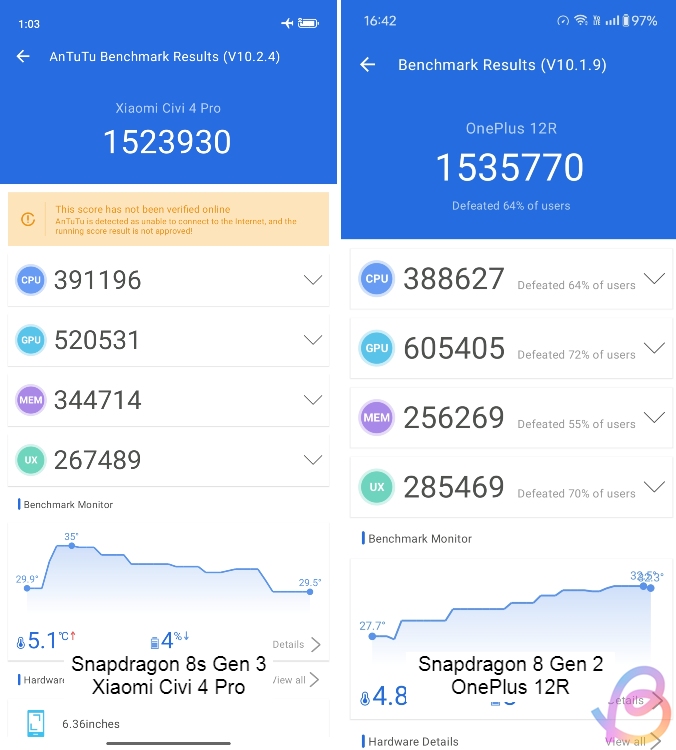
CPU Throttling Test
In the CPU Throttling test, the Snapdragon 8s Gen 3 did a much better job than the Snapdragon 8 Gen 2. As the 8s Gen 3 packs newer cores having better efficiency, it can sustain a high workload on its CPU without sacrificing performance.
In the 15-minute test, the Snapdragon 8s Gen 3 throttled to 94% of its maximum performance whereas the Snapdragon 8 Gen 2 throttled to 75% of its maximum performance. However, this also depends on the cooling system used by OEMs and how well they’ve implemented it.
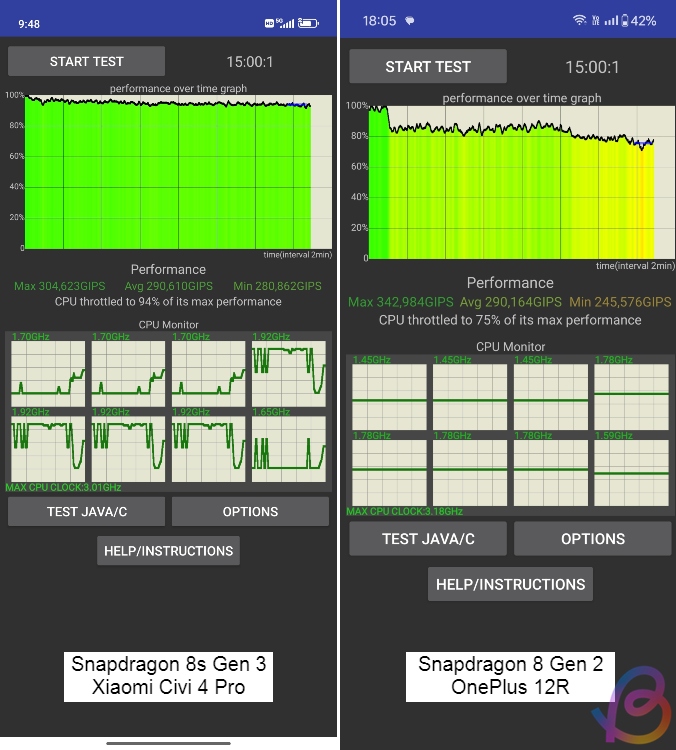
Geekbench GPU Test
Since 3DMark kept crashing on the Xiaomi Civi 4 Pro, we did the Geekbench GPU test to find the performance difference between both Adreno GPUs. The Adreno 735 GPU on the Snapdragon 8s Gen 3 got 8,838 in the OpenCL test and 10,154 in the Vulkan test.
In comparison, the Adreno 740 GPU on the Snapdragon 8 Gen 2 SoC scored a bit higher in the OpenCL test, achieving 9,133 points. However, in the Vulkan test, the 8 Gen 2 scored 9,109 points. I’d say both GPUs are quite capable with support for hardware-accelerated ray tracing and are both equally matched.
| Geekbench 6 GPU | Snapdragon 8s Gen 3 | Snapdragon 8 Gen 2 |
|---|---|---|
| OpenCL | 8,838 | 9,133 |
| Vulkan | 10,154 | 9,109 |
AI Performance Test
For the final AI performance test, we ran the Geekbench ML app to evaluate the NPU performance of both chipsets. The Snapdragon 8s Gen 3 scored 612 and Snapdragon 8 Gen 2 got 383 points. The low score of both chipsets might be attributed to the fact that Qualcomm chipsets currently don’t support the NNAPI backend properly. We tried to run other AI benchmarking apps, but Xiaomi Civi 4 Pro refused to launch those apps.
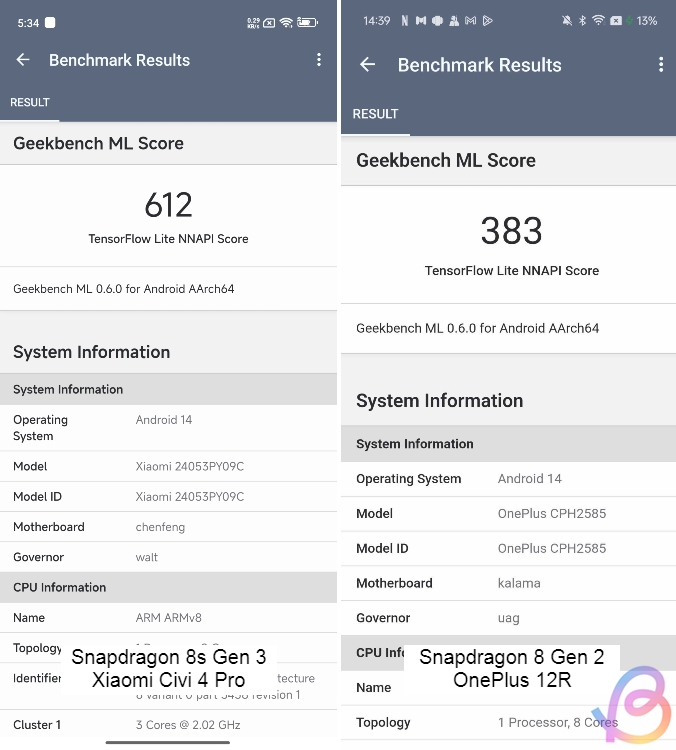
The Verdict: Snapdragon 8s Gen 3
The new Snapdragon 8s Gen 3 from Qualcomm matches the performance of the Snapdragon 8 Gen 2 in nearly all areas. If I had to choose a chipset between the two options, I would definitely go with the Snapdragon 8s Gen 3. Why? It boasts slightly underclocked but newer ARM cores which would improve the battery life and thermal performance of the chipset.
But that’s my opinion and choice at the end of the day. What do you think about the Snapdragon 8s Gen 3? Would you pick it over the previous-gen Snapdragon 8 Gen 2? Let us know in the comments below.

